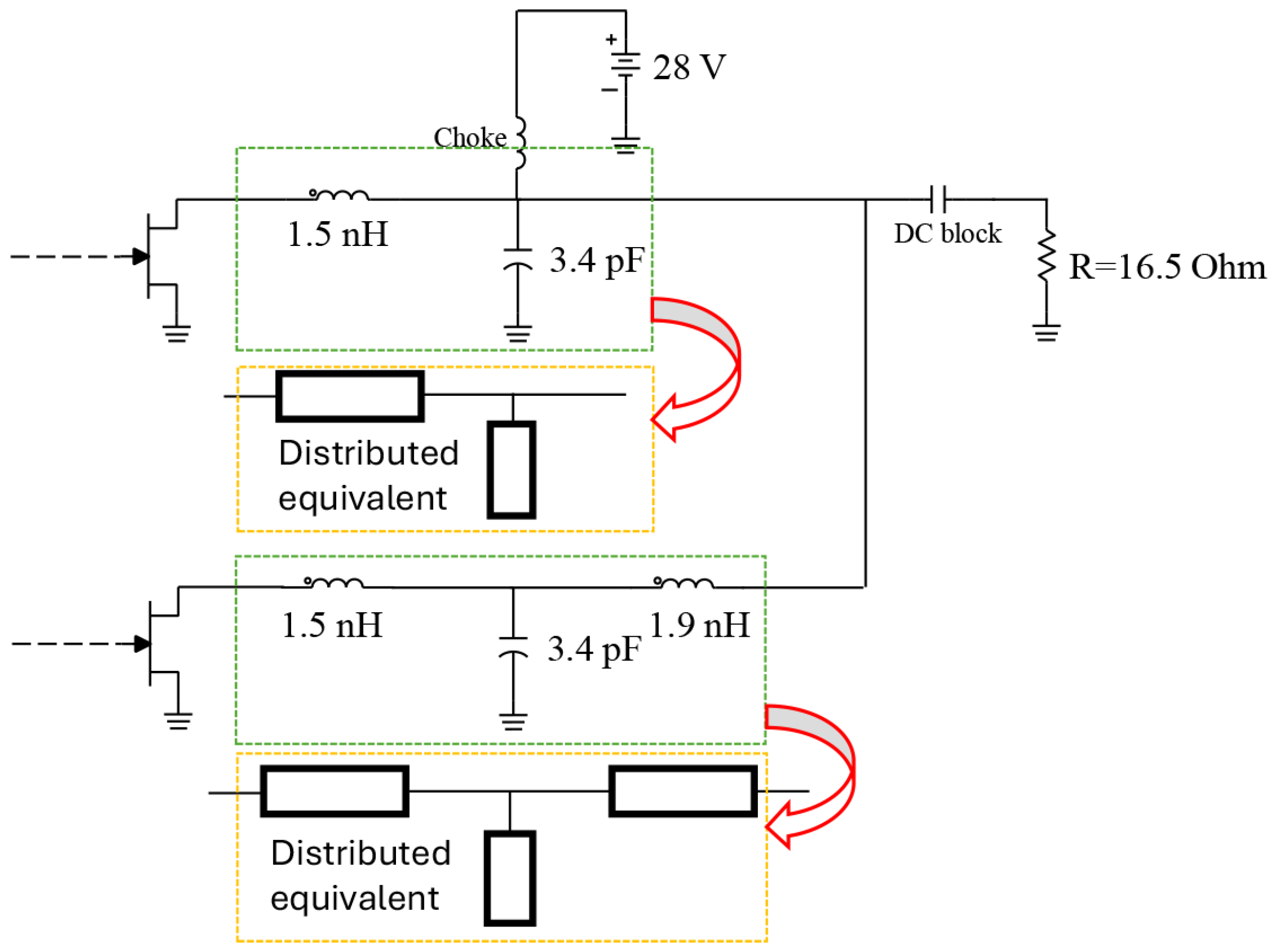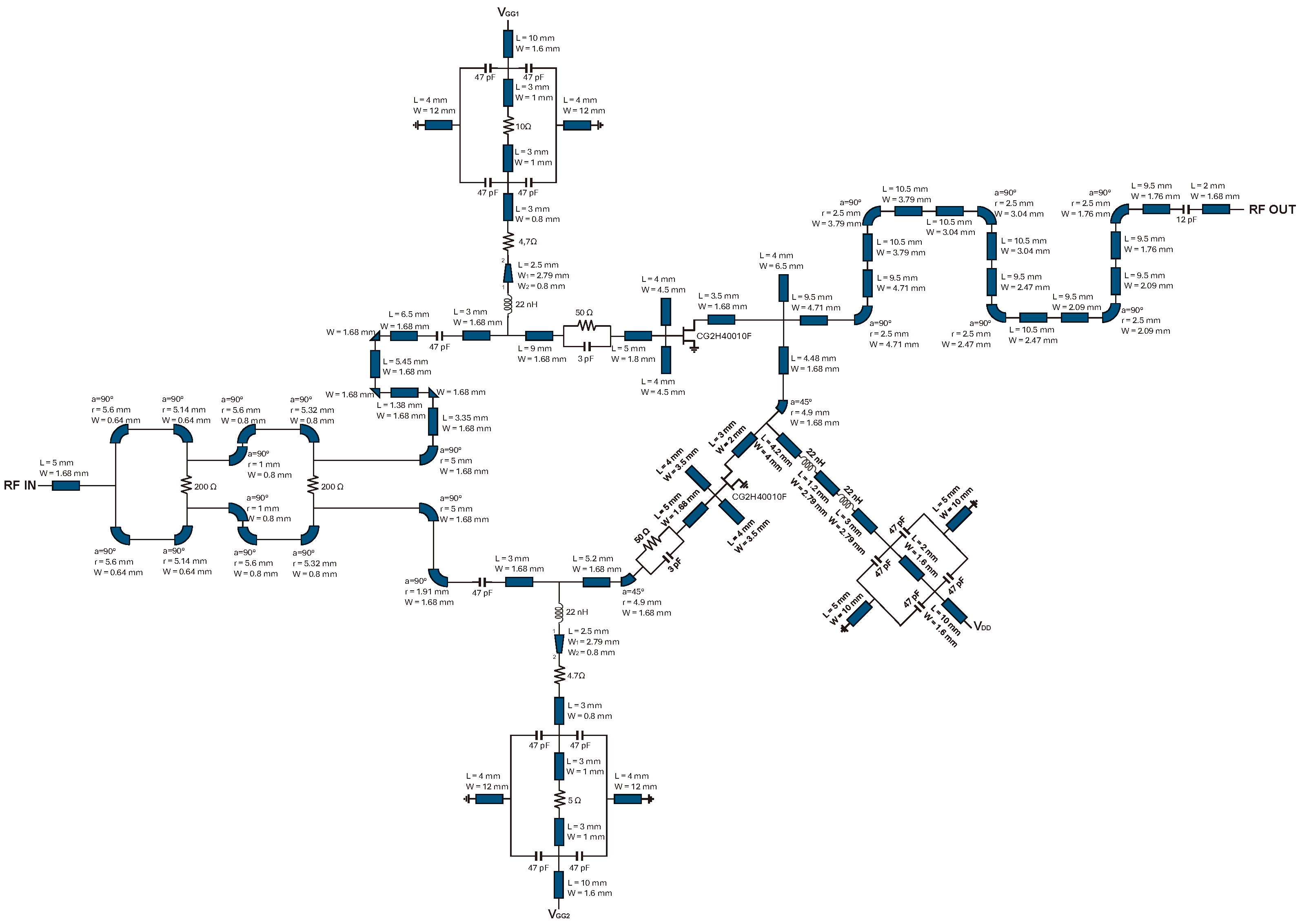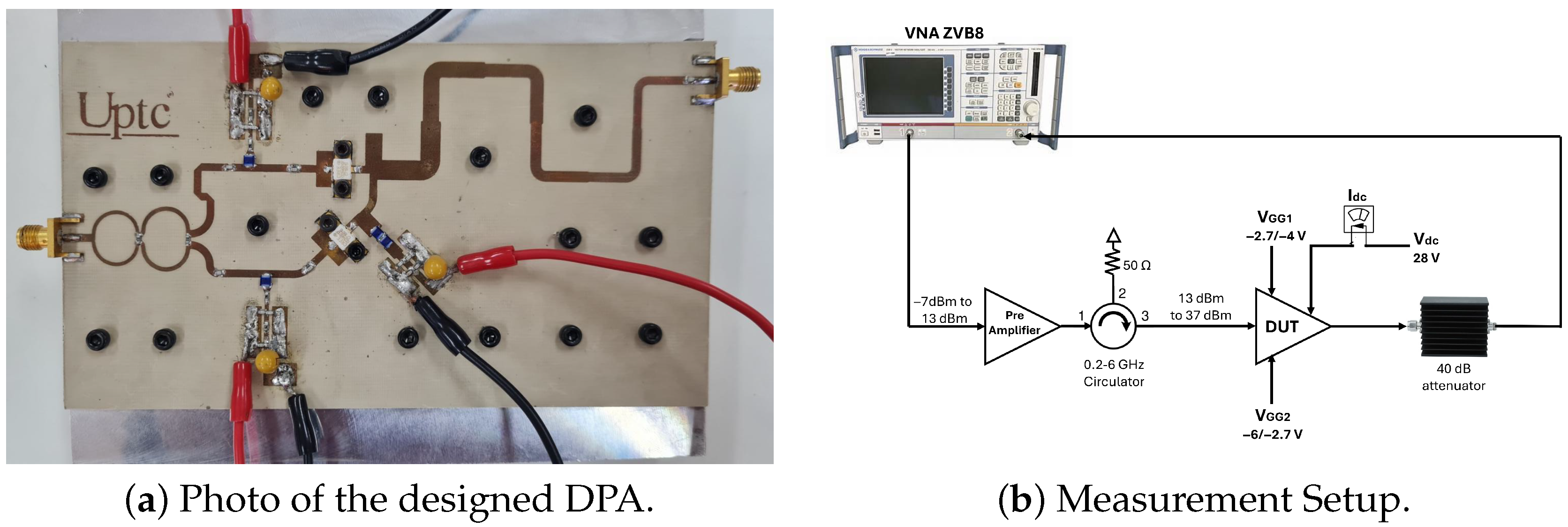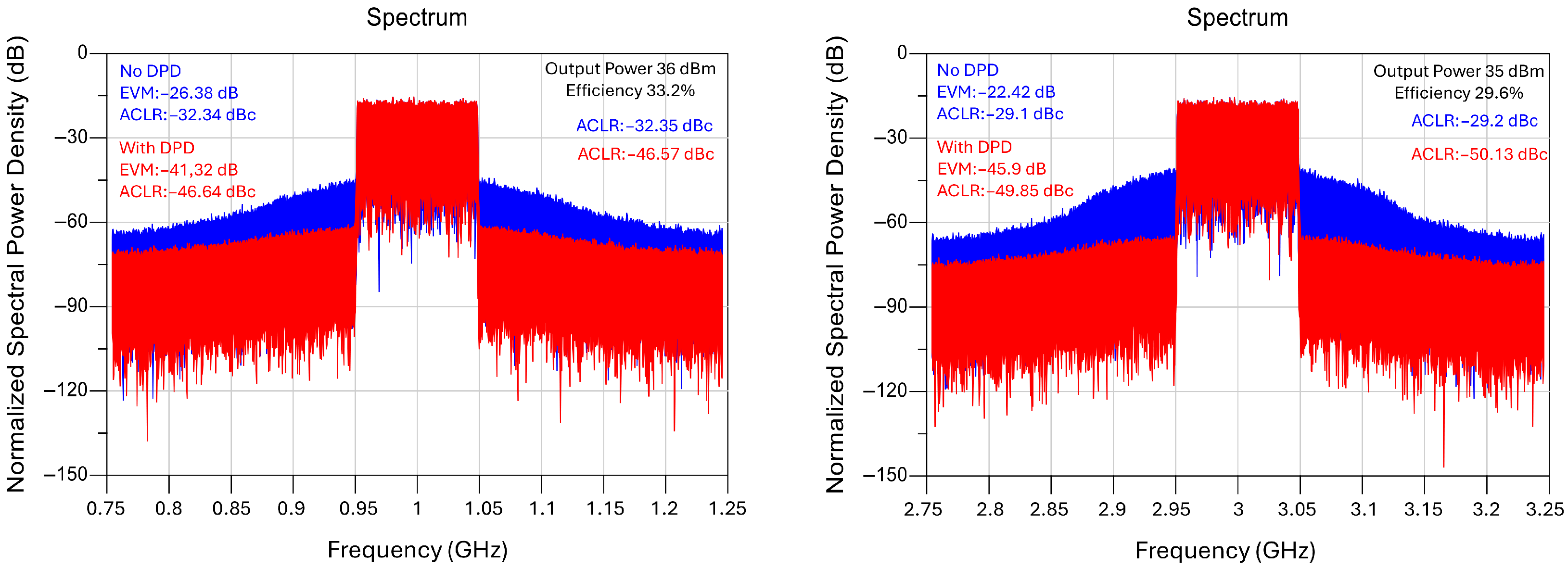An Adaptive Bi-Band Doherty PA with Main-Peak Amplifier Swapping and Extended Bandwidth Performance
Abstract
1. Introduction
2. Design
2.1. Transmission Line Equivalence and Impedance Inversion
2.2. Utilizing the Equivalent Reactive Output Network of FETs to Emulate a Low-Pass CLC Network
2.3. DPA Architecture Based on CLC Networks
3. Implementation and Characterization
4. Conclusions
Author Contributions
Funding
Acknowledgments
Conflicts of Interest
References
- Ardekani, M.H.M.; Abiri, H. A new design procedure for wide band Doherty power amplifiers. AEU–Int. J. Electron. Commun. 2018, 98, 181–190. [Google Scholar] [CrossRef]
- Zhang, Z.; Cheng, Z.; Liu, G.; Zhang, Z.; Cai, Y. Design of a broadband high-efficiency doherty power amplifier for 5G communication systems. IEICE Electron. Express 2019, 16, 20190371–20190371. [Google Scholar] [CrossRef]
- Jia, P.; You, F.; He, S. A 1.8-3.4-GHz Bandwidth-Improved Reconfigurable Mode Doherty Power Amplifier Utilizing Switches. IEEE Microw. Wirel. Compon. Lett. 2019, 30, 102–105. [Google Scholar] [CrossRef]
- Nikandish, G.; Staszewski, R.B.; Zhu, A. Breaking the bandwidth limit: A review of broadband doherty power amplifier design for 5G. IEEE Microw. Mag. 2020, 21, 57–75. [Google Scholar] [CrossRef]
- Cao, Y.; Chen, K. Pseudo-Doherty Load-Modulated Balanced Amplifier with Wide Bandwidth and Extended Power Back-Off Range. IEEE Trans. Microw. Theory Tech. 2020, 68, 3172–3183. [Google Scholar] [CrossRef]
- Nasri, A.; Estebsari, M.; Toofan, S.; Piacibello, A.; Pirola, M.; Camarchia, V.; Ramella, C. Design of a wideband doherty power amplifier with high efficiency for 5G application. Electronics 2021, 10, 873. [Google Scholar] [CrossRef]
- Fu, C.; Wang, N.; Chen, X.; Chen, W. A Concurrent Dual-band Continuous Mode Doherty Power Amplifier with Improved Bandwidth and Linearity for 5G Base-Stations. In Proceedings of the 2022 IEEE Conference on Antenna Measurements and Applications (CAMA), Guangzhou, China, 14–17 December 2022; pp. 1–4. [Google Scholar] [CrossRef]
- Haider, J.; Zhou, H.; Saad, P.; Hou, R.; Fager, C. Design and Validation of a Concurrent Dual-Band 1.84/2.65 GHz GaN Doherty Power Amplifier. In Proceedings of the 2023 International Workshop on Integrated Nonlinear Microwave and Millimetre-Wave Circuits (INMMIC), Aveiro, Portugal, 8–11 November 2023; pp. 1–4. [Google Scholar] [CrossRef]
- Zhong, K.; Dai, Z.; Xiao, F.; Gao, R.; Shi, W.; Pang, J.; Li, M. Design of Dual-Band Doherty Power Amplifier Using a New Phase Compensation Technique. IEEE Trans. Circuits Syst. II Express Briefs 2024, 71, 1794–1798. [Google Scholar] [CrossRef]
- Rubio, J.J.M.; Noori, A. Doherty Power Amplifier Design via Differential Combining. Electronics 2024, 13, 3961. [Google Scholar] [CrossRef]
- Piacibello, A.; Camarchia, V. High-Efficiency GaN Doherty Power Amplifier based on Inverse Class-F Operation. In Proceedings of the 2024 IEEE Topical Conference on RF/Microwave Power Amplifiers for Radio and Wireless Applications, San Antonio, TX, USA, 21–24 January 2024; pp. 5–8. [Google Scholar] [CrossRef]
- Sun, P.; Han, F.; Liu, Z.; Qi, Q.; Li, X.; Wang, X. A Broadband Doherty Power Amplifier Design with 22.4-dBm Psat and 31% PAE in 45-nm SOI CMOS for 5G Application. IEEE Inf. Technol. Mechatron. Eng. Conf. ITOEC 2025, 8, 1075–1079. [Google Scholar] [CrossRef]
- Tao, M.; Chen, Y.; Kong, W.; Ni, S.; Zheng, Z.; Xia, J. Design of Dual-Mode Multi-Band Doherty Power Amplifier Employing Impedance-and-Phase Constrained Optimization. Electronics 2025, 14, 2078. [Google Scholar] [CrossRef]
- Rubio, J.J.M.; Camarchia, V.; Pirola, M.; Quaglia, R. Design of an 87% Fractional Bandwidth Doherty Power Amplifier Supported by a Simplified Bandwidth Estimation Method. IEEE Trans. Microw. Theory Tech. 2017, 66, 1319–1327. [Google Scholar] [CrossRef]
- Chen, S.; Xue, Q. Compact triple-transistor doherty amplifier designs: Differential/power combining. IEEE Trans. Microw. Theory Tech. 2013, 61, 1957–1963. [Google Scholar] [CrossRef]
- Mohamed, A.M.M.; Boumaiza, S.; Mansour, R.R. Reconfigurable doherty power amplifier for multifrequency wireless radio systems. IEEE Trans. Microw. Theory Tech. 2013, 61, 1588–1963. [Google Scholar] [CrossRef]
- Giofre, R.; Piazzon, L.; Colantonio, P.; Giannini, F.; Camarchia, V.; Quaglia, R.; Pirola, M.; Ramella, C. GaN-MMIC Doherty power amplifier with integrated reconfigurable input network for microwave backhaul applications. In Proceedings of the 2015 IEEE MTT-S International Microwave Symposium, Phoenix, AZ, USA, 17–22 May 2015; pp. 2–4. [Google Scholar] [CrossRef]
- Kalyan, R.; Rawat, K.; Koul, S.K. Design of reconfigurable concurrent dual-band power amplifiers using reconfigurable concurrent dual-band matching network. In Proceedings of the 2016 IEEE MTT-S International Wireless Symposium (IWS), Shanghai, China, 14–16 March 2016; pp. 1–4. [Google Scholar] [CrossRef]
- Darraji, R.; Bhaskar, D.; Sharma, T.; Helaoui, M.; Mousavi, P.; Ghannouchi, F.M. Generalized Theory and Design Methodology of Wideband Doherty Amplifiers Applied to the Realization of an Octave-Bandwidth Prototype. IEEE Trans. Microw. Theory Tech. 2017, 65, 3014–3023. [Google Scholar] [CrossRef]
- Ramella, C.; Piacibello, A.; Quaglia, R.; Camarchia, V.; Pirola, M. High efficiency power amplifiers for modern mobile communications: The load-modulation approach. Electronics 2017, 6, 96. [Google Scholar] [CrossRef]
- Joonhyung, K. Highly Efficient Asymmetric Class-F-1/F GaN Doherty Amplifier. IEEE Trans. Microw. Theory Tech. 2018, 66, 4070–4077. [Google Scholar] [CrossRef]
- Liu, Y.-J.; Zhou, J.; Chen, W.; Zhou, B.-H. A Robust Augmented Complexity-Reduced Generalized Memory Polynomial for Wideband RF Power Amplifiers. IEEE Trans. Ind. Electron. 2014, 61, 2389–2401. [Google Scholar] [CrossRef]









Disclaimer/Publisher’s Note: The statements, opinions and data contained in all publications are solely those of the individual author(s) and contributor(s) and not of MDPI and/or the editor(s). MDPI and/or the editor(s) disclaim responsibility for any injury to people or property resulting from any ideas, methods, instructions or products referred to in the content. |
© 2025 by the authors. Licensee MDPI, Basel, Switzerland. This article is an open access article distributed under the terms and conditions of the Creative Commons Attribution (CC BY) license (https://creativecommons.org/licenses/by/4.0/).
Share and Cite
Moreno Rubio, J.J.; Angarita Malaver, E.F.; Mesa Lara, J.A. An Adaptive Bi-Band Doherty PA with Main-Peak Amplifier Swapping and Extended Bandwidth Performance. Inventions 2025, 10, 69. https://doi.org/10.3390/inventions10040069
Moreno Rubio JJ, Angarita Malaver EF, Mesa Lara JA. An Adaptive Bi-Band Doherty PA with Main-Peak Amplifier Swapping and Extended Bandwidth Performance. Inventions. 2025; 10(4):69. https://doi.org/10.3390/inventions10040069
Chicago/Turabian StyleMoreno Rubio, Jorge Julian, Edison Ferney Angarita Malaver, and Jairo Alonso Mesa Lara. 2025. "An Adaptive Bi-Band Doherty PA with Main-Peak Amplifier Swapping and Extended Bandwidth Performance" Inventions 10, no. 4: 69. https://doi.org/10.3390/inventions10040069
APA StyleMoreno Rubio, J. J., Angarita Malaver, E. F., & Mesa Lara, J. A. (2025). An Adaptive Bi-Band Doherty PA with Main-Peak Amplifier Swapping and Extended Bandwidth Performance. Inventions, 10(4), 69. https://doi.org/10.3390/inventions10040069






